The Life of Titan
Life
is everywhere
on Titan. It's not the microbes which space scientists vainly search
for wherever there's liquid water, but pole to pole forests of gigantic
trees, and luxuriant growths of aquatic vegetation of a scale not seen
on Earth. The life chemistry is supported by the liquid methane seas,
lakes and rivers, and a nearly Earth-pressure atmosphere of nitrogen
with hydrogen as the breathing gas.
Every image and every instrument return from the Huygens
lander and the Cassini space probe reinforces the view and evidence of
this life and none which seem credible contradict it. So far space
scientists have remained oblivious to it, and instead are puzzled and
misled by many of the findings of their own instruments. They come up
with strange theories as to their meanings. If these very same findings
had come from Mars, the same people would be jumping up and down saying
"Mars is alive!", but coming from a "deep freeze" world where Earth
life wouldn't survive 2 minutes, they simply can't conceive that such a
different life to ours is existing and thriving.
Titan, with its liquid methane seas, tides, Earth pressure
atmosphere
and similar polar tilt, is amazingly like the Earth in some ways, but
not
in ways that would make it a comfortable place for Earth people. Not
only
is there 1/7 gravity and a very long day (16 Earth days) and very long
seasons (the year is 30 Earth years), but the temperature is 1/3 that
of the Earth (94°K versus 290°K) and hence the life chemistry
is
vastly different. With seas of
liquid methane, it seems likely that plants take in methane and turn it
into carbon (coal? Tree trunks!) plus the obvious energized breathing
gas, hydrogen,
much as plants here (re)generate oxygen from carbon dioxide. Titanian
vegetation seems to
attain
a scale that is probably best explained by the low gravity and (in the
tropical seas) the need
to flourish in strong tides. It has many similarities to Earth plants,
but a possible major functional difference as well. I wish to speculate
on the nature and biochemistry of Titanian life, but first let's have a
look at the meat of the matter: what the Cassini probe and the Huygens
lander have actually shown us!
=========================
Excerpts of Emails with Ralph Lorenz
I hear the GCMS team says the spectrum indicates the "ice rocks" in
the landed images "definitely" aren't made of ice. (I didn't know the
GCMS looked externally... should that have been the DISR team?)
For a while I thought they were rocks too, but I figured out what they
really were a couple of months ago, neither rocks nor ice. I
confidently say you'll see lots of complex organic compounds when the
spectrographic results are released - spectra of life.
Sagan
"extraordinary claims require extraordinary evidence"
PS: I've modified my description of Titan's tides a bit to include your
figures: 100m bulge, 9%=9m bulge variance over orbit, and I mention
this is versus 18cm variance for Earth. (Are there any estimates how
much Titan might flex internally over an orbit? - this would have to be
subtracted from the 9m tidal "head".)
>btw - no-one would have like to have found liquids on Titan more
than me (well, perhaps Jonathan Lunine)
>Whatever people think they are seeing in the highly compressed DISR
images, the evidence is just
>not good enough to say it is there, let alone to contradict the
measurements from the other sensors.
"As I've said, we'd be happy to discover liquid. We didn't. You
can say
you see pink aliens, or liquid, or cities of gold in the images." -
Ralph Lorenz
=============================
The Forests of Titan (Cassini)
(Jan 2023)
(Note: My original version of this 'book' was written before the
discovery and extensive charting of forests on Titan's land areas by
Cassini's SAR [Synthetic Aperture Radar] 2.4cm radar instrument, and
also before the discovery of the dunes submerged in the tropical tidal
seas. I now include sections devoted to these topics.)
The Cassini SAR images of Titan's land areas, allowing for
the difference between radar and visual images (eg, Google Earth), look
like forests and unlike any other land surfaces found anywhere in the
solar system besides Earth.
And yet the space scientists couldn't see it, and
eventually offered a rather bizarre explanation as to why the images
were so lumpy rather than smooth.
The trees are "Titanic" by Earth standards, having been
measured by SAR readings as being up to 2 kilometers tall. This height
estimate was originally released in an article claiming Titan had
"underground caves", and that furthermore the radar returns were so
ethereal as to indicate that the ground for the first two kilometers
was mostly filled with air! The obvious explanation is that the radar
was looking into a forest canopy.
How could trees possibly be so tall? This is probably a
factor in the disbelief. What limits the height of trees on Earth? It
is said that leaves can only suck moisture up from the roots for about
120 meters. Earth's tallest trees, redwoods in California and
eucalyptus in Tasmania, live in areas of light winds and still max out
at about 140 meters. It is said that at the treetops it often looks
like there's drought even while there's plenty of moisture further down.
If we take 140 meters and then multiply by Titan's 1/7 of
Earth's gravity and then factor in liquid methane being only 80% as
dense as water, we get: 140 * 7 / .8 = 1,225 meters as the maximum
height for trees on Titan. That would be if all else was equal, which
is surely unlikely, but it shows that two kilometer tall trees is in
the right ballpark. Height means much less on Titan than on Earth. Even
the atmosphere extends much farther into space than ours, so that on
the highest mountains the air is practicly no thinner than at sea level.
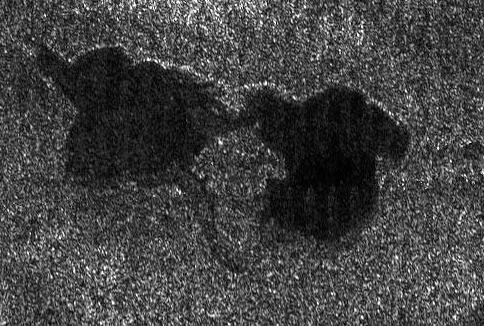
Titan's "Kissing Lakes" - from a Cassini radar sweep. (shown x2
scale, south up)
Lest this be thought to be "off the wall", one amateur
opinion based on wild imagination, I sent the above image to a
professional cartographer who looked at satellite images every day by
email, without telling him anything about it. I said I would tell
him the latitude and longitude after he evaluated it, and of course he
assumed it was on Earth. He unhesitatingly pronounced
this to be a "shallow lake" surrounded by "mixed forest" in "quite flat
terrain", and he mentioned where runoff appeared to flow into and out
of the lake. (Right & upper left) Quite flat terrain is typical of
Titan.
To get as much mileage as I could, I asked him "Why
shallow?" and he replied
"vegetation appears to be growing out of it. But it could be radar
noise." Titan's prolific aquatic vegetation, as seen close up by the
Huygens lander, is of a scale unknown here on Earth. And unlike with
water, Cassini's SAR radar saw deep into liquid methane.
He could see it was a
radar image. He tried to guess which
Earth satellite had taken the image, naming 2 or 3 possibilities from
satellites he knew. And he also made a guess as to the ground scale.
Only then did I tell him it was from the Cassini, and the world was
Titan, not Earth, that the lakes were liquid methane and
that the actual scale of 120 meters per pixel made the trees hundreds
of meters tall. BTW: 73°N, 46°W. (Then he tried to recant and
say it wasn't trees after all, but I told him I was sure he had it
right.)
There is radar swath after radar swath from the poles to
the equator, at resolutions as fine as a couple of hundred meters
per pixel, all showing that Titan's entire land area is enveloped in
verdant forest. They were recorded in various directions, some
overlapping. Were the trees Earth sizes, the texture might be so fine
as to be indecipherable.
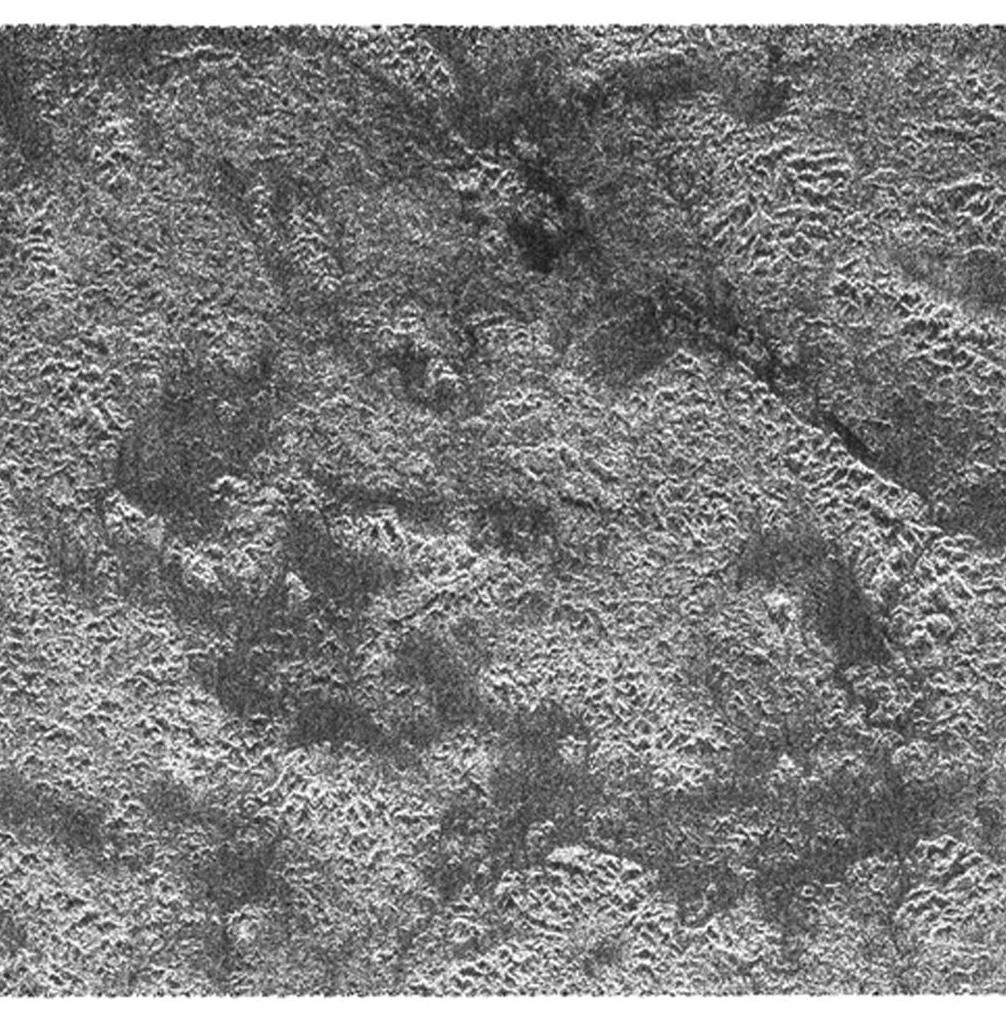 In the full
version of this image clip, Cassini's 2.4cm Synthetic Aperture
Radar (SAR) radar records
In the full
version of this image clip, Cassini's 2.4cm Synthetic Aperture
Radar (SAR) radar records
in detail here as fine as about 225 meters per pixel, a typical swath
of Titan landscape from a tropical
duney tide-flow sea through a forested region with gigantic trees in a
region they named "Xanadu".
(Note that things looking like gigantic horizontal "branching"
structures in forests
are generally the canopies of rows of trees rather than individual
features.
Also: unlike water, Cassini's SAR radar can see deep into liquid
methane,
so submerged features and vegetation merely look darker than those in
air.)
Huygens Lander Instrument Readings
Indicating Titanian
Life
(Feb 5 2006)
In December 2005, results of the Huygens
spectrographic findings
were published in Nature. Having observed vegetation
ubiquitous
in the images, I was expecting to hear of "complex organic compounds"
on
the surface, without knowing just what these might be, and the reports
didn't disappoint me. The synopsis was:
"The
infrared reflectance spectrum measured
for
the surface is unlike any other in the Solar System; there is a red
slope
in the optical range that is consistent with an organic material such
as
tholins, and absorption from water ice is seen. However, a blue slope
in
the near-infrared suggests another, unknown constituent."

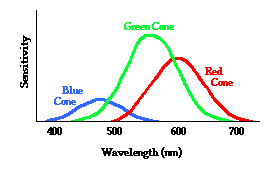
Handy Earthling eyes spectrum references, courtesy
http://www.glenbrook.k12.il.us/gbssci/phys/Class/light/u12l2b.html
The "tholins" finding does
indicate complex organics.
Going into more detail:
"The four major characteristics
of the surface
spectrum are: (1) a relatively low albedo, peaking around 0.18 at 830
nm;
(2) a red slope in the visible range; (3) a quasilinear decrease of the
reflectivity by a factor of about two between 830 and 1,420 nm; and (4)
a broad absorption, by ~30% of the local continuum, apparently centred
near 1,540nm (although its behaviour beyond 1,600nm is poorly
constrained)
as seen in Fig. 15b. This spectrum is very unusual and has no known
equivalent
on any other object in the Solar System."
Item one says it's a dark color,
reflecting at the
most,
18% of sunlight, and that the brightest color is in a near
infra-red
wavelength. Item four says Titan's surface is unique and mysterious. Of
specific interest:
"... a featureless blue slope
is not matched
by
any combination of laboratory spectra of ices and complex organics,
including
various types of tholins. Depending on their composition and structural
state (for example, abundance, extension and/or clustering of sp2
carbon
bonds), organic materials in the near-infrared exhibit either distinct
absorption bands (for example, bright yellow-orange tholins), or a
feature-poor
red slope (for medium to low-albedo organics), or a very dark and flat
spectrum."
It was also said that the brighter
"terrain" showed
more
redder than the darker, from which I very tentatively infer, along with
the
blue, that the leaves and-or soil are a purplish color, with the sea
liquid
more of a green. The final note on the blue slope was:
"Assessing the material
responsible for the
blue
slope is a major challenge and also a prerequisite for a secure
identification
of the 1,540nm band."
I predict failure for finding any
inert "chemical"
that will mix with water ice to create the unknown absorption bands. I
suspect instead that it's unique to Titan life chemistry. Of course, it
could instead be some inert chemicals that don't even include the
expected
water ice and will be identified, but I doubt it somehow.
"Aerosols" such as ammonia (NH3), end
products of a
complex
organic chemistry, were found by cooking the surface materials found at
the inlet to the GCMS, which were mostly liquid methane, but evidently
included some other things.
"Compounds not
seen in the
atmosphere,
such as C6H6, C2N2 and CO2, were nevertheless detected in the gas from
the surface material. Those measurements, which have not yet been fully
analysed, appear to indicate complex chemical processes
occurring on or
in Titan’s surface, as well as in the atmosphere."
A question is: What might drive
complex and
apparently
active organic chemical processes? There seems to be no evidence for
geological
activity. Winds are light at the surface and there's virtually no UV or
short wave light down there, there being the equivalent of Titanian
ozone
layers high up. I probably lack imagination, but I just keep thinking
it
can't be anything except life.
An argument that has been used
against life on Titan
is
the isotopic mix of certain elements, particularly carbon 12 versus
carbon
13 in the atmospheric methane. This works on Earth, but with unknown
life
chemistry, it is just as likely plants are expelling one isotope to get
rid of it as it is that they are trying to collect that isotope.
Exobiologist
David Grinspoon said this on the matter in an interview:
"I think it's likely
that life will result
in distinct isotopic signatures, and it's one of the kinds of clues
that
we should be looking for. At the end of our paper, we list some
possible
biosigns on Titan, and unusual isotopic fractionation is one of them.
But
we don't know what kinds of isotopic fractionations alien life will
make.
Also, we don't know what other fractionations are naturally occurring
on
Titan. Gases escaping from the atmosphere fractionates the carbon, but
we don't know how much this process affects the isotopes. The problem
is
not well enough constrained to rule out life, or to prove life at
present."
It's the images that offer the real
proof.
Huygens
Views of
Titanian Life
The
content of
Huygens's images of Titan
is breathtaking, even though the quality leaves much to be desired.
Nobody, myself included, expected to
actually see
life there in the
Huygens images. That Titan might have life was almost inconceivable. If
it did, it would be algae and microbes Huygens wouldn't be able to see.
But there they were in the descent images... something that looked like
the head of a seal, sticking out of the water!... something perhaps
swimming!...
a squid!... a giant newt on the bottom!... Well, these were just
impossible given the scale. But there were various vague forms that
didn't
look geological, here and there!... something quite mysterious in the
water!
And even more astonishing, areas that seemed to be land that appeared
to be organized
in some way! These are the signs of Titanian life Huygens has given us
a glimpse of. Intrigued, finally I broke the perceptual barrier and
recognized vegetation. The actual main feature of the landscape was
aquatic plants!
In retrospect, it is
far more likely in random shots of a world that one will capture the
images
of vegetation, which should be "everywhere" and may be very large, than
catch a fleeting glimpse of relatively small and probably sparse animal
life. One doesn't look down from orbit and see monkeys, sloths
and eagles: one sees the rainforest canopy. Vegetation is what anyone
searching planetary images should be
searching for if in quest of life. It seems so obvious in retrospect!
We all want better, and color,
pictures, but we
don't have them and
we won't for the foreseeble future. It is up to the viewer to decide
whether
it is more believable that so many things are illusions that just mimic
vegetative forms, or whether they actual plants, and whether rather
distant
views of land that seems to have vegetation are just that, or flukes of
the Titanian landscape, light and shadow. I present them here as if
they
are what they appear to be, as much as I've been able to make sense of
them. Making sense of Titan's plant life has taken some time and I
can't
claim to have all the answers. While the scale of Titanian vegetation
boggles
the mind, pause to consider that here on Earth,
it is said that a single rye plant can spread up to 400 miles of roots
underground and many other examples of kilometric plant root and fungus
lengths can be cited.
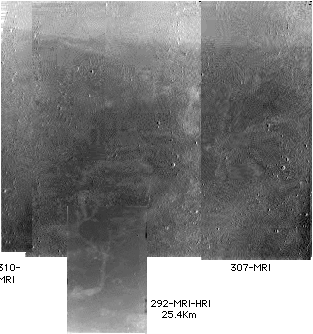
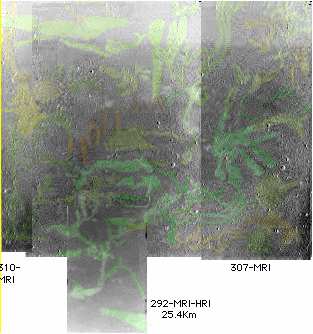
Vague, murky shapes in the sea, from 25 Km
up. How could so many
bizarre things huddle together in one place? They appear to be giant
aquatic
plants! We see huge stems, branches, leaves, and perhaps even some
roots.
(The "bubbles" are methane frost or dew on the camera lens, as is the
light colored band at the
top. These are ubiquitous in the MRI (medium rez imager) but there are
a few in the HRI (high rez, downward looking) imager as well) The tidal
flow runs East - West through
Huygens'
channel. The lighter colored areas are likely mats of leaves, or
surface
reflections, but some patches are probably shallower 'water'.
Scale is about 3-1/2 Km left to right; South is towards the top;
land is not far below the "bent arrow" feature and the bottom of the
image,
shallower 'water' perhaps explaining the lighter shade at the bottom.
The
colorized image attempts to show the real forms in the original image
but
contains much "artistic licence" as fine points of detail in the
Huygens
images are often distorted and unclear. The true colors are of course
unknown.
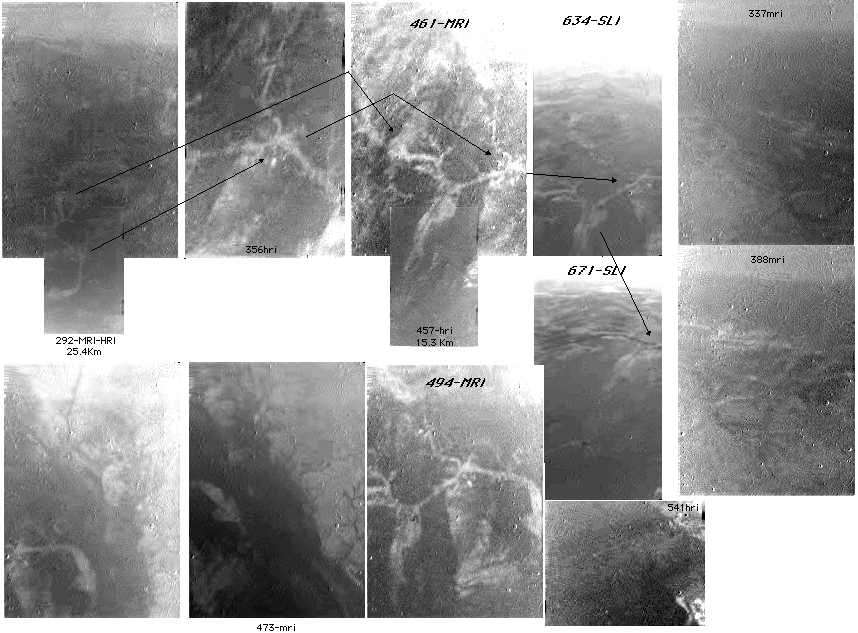
Here we follow the plants down in altitude,
obtaining different
views
of them. Again, various leaves and stems are in view. Following the
arrows
to a cluster of leaves, in 671 we finally get a vague glimpse of the
stem
holding that giant "leaf" (or whatever it is) up. The three dimensional
nature of the scene - objects in the sea rather than just flat ground -
seems to be demonstrated as the appearance changes with differing
points
and angles of view.
Also some other selected images of aquatic plants are shown: Bottom
left, some shots of the "bent arrow". Right side, stems rising up from
the sea floor, one at the lower right in 337-mri and more centrally in
388-mri splits into 3 veins at the base of a huge leaf the surface. The
whitish "island" towards the right in 337 is probably also a leaf mat -
we see it floating above a deep area rather than being shallow 'water'
forming a shoreline.
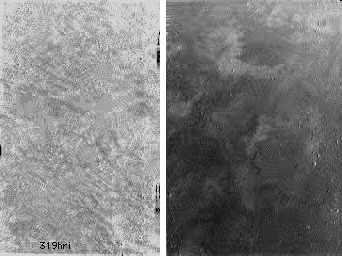
Oodles of seaweed! Titan's tidal waterways seem as choked with giant
plants
as Earthly duck ponds or swamps are with small ones.
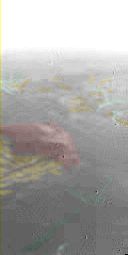
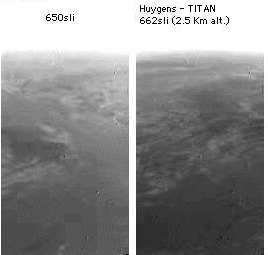
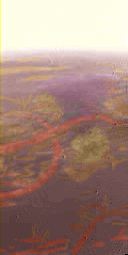
Whitecaps and sprays from the "Seas" chapter again. This time, let's
look
at the other features.
Those seem to be plant leaves or a stem that the
flow hits to make that spray. Left:
Big leaves are seen sticking out of the liquid in the
background.
Right: There are many stems in the water; some large light colored
ones
curving around and some smaller dark, "jagged" ones with leaves.
Having re-examined these as I colorized them, I suspect the main
features aren't sprays of liquid at all.
The edges as seen on the left
(650) are so well defined it seems more like a leaf sticking out of the
water.
Titan doesn't seem to need study by space scientists so much as by
biologists
and bio-chemists!
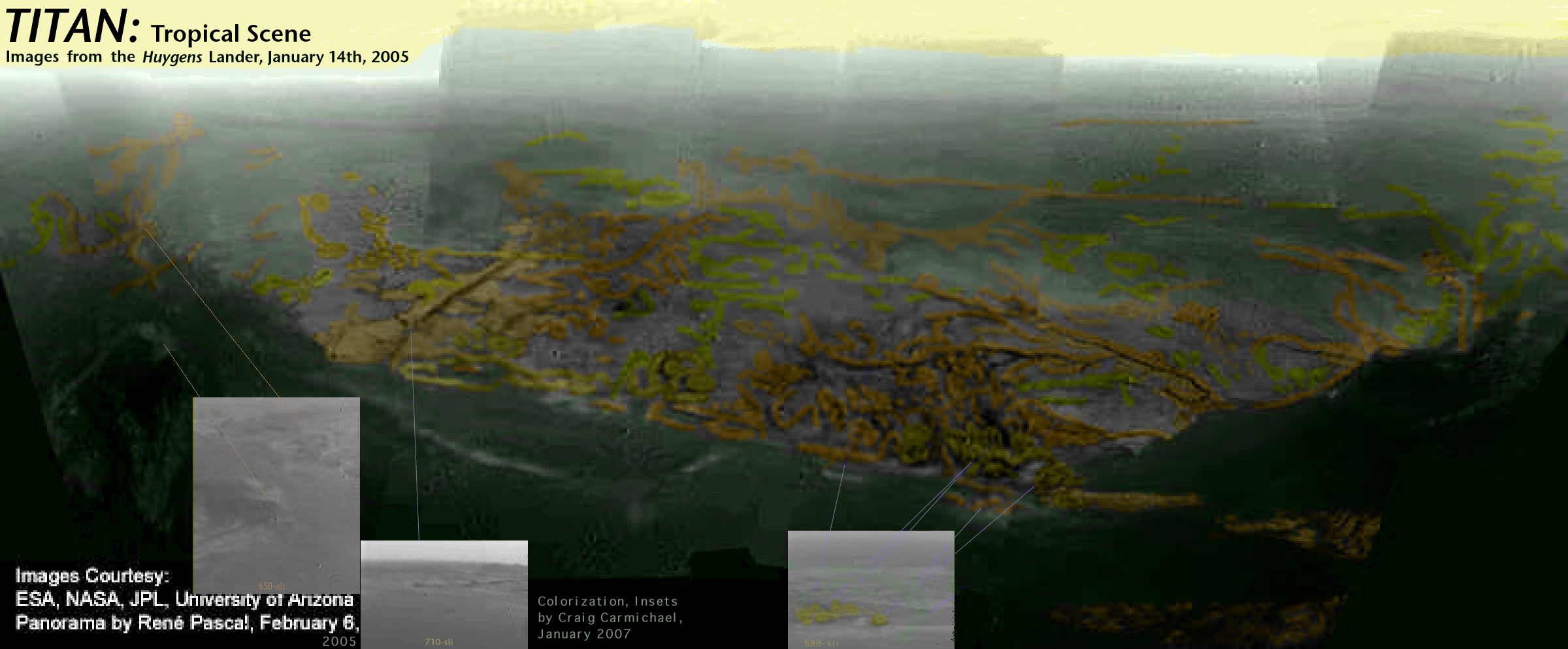 Here is a scene
mosaiced from Huygens' descent images. The
insets show certain of the features as seen by the side looking imager
towards the end of the descent.
Noteworthy are the "bent arrow" (SLI-650), the "pipeline" (SLI-710),
and the "seal faces" (SLI-698).
Studying Titan gradually discloses that these are scenes of profuse
aquatic
vegetation in a shallow body of flowing liquid full of mud or sand
bars, often in the form of undersea dunes. What appears to be a
substantial island at first look turns out to be rafts of floating
vegetation in a shallow area. Utterly contrary to the inital conclusion
that Huygens saw
no liquid, it would seem that it actually saw no land! The sea depth
varies from the deep troughs to the crests of the dunes, and the
intensity of the
vegetation changes greatly with the depths. Huygens landed on perhaps
the
shallowest spot in the whole area, only a few centimeters deep on a
small mud bar.
Here is a scene
mosaiced from Huygens' descent images. The
insets show certain of the features as seen by the side looking imager
towards the end of the descent.
Noteworthy are the "bent arrow" (SLI-650), the "pipeline" (SLI-710),
and the "seal faces" (SLI-698).
Studying Titan gradually discloses that these are scenes of profuse
aquatic
vegetation in a shallow body of flowing liquid full of mud or sand
bars, often in the form of undersea dunes. What appears to be a
substantial island at first look turns out to be rafts of floating
vegetation in a shallow area. Utterly contrary to the inital conclusion
that Huygens saw
no liquid, it would seem that it actually saw no land! The sea depth
varies from the deep troughs to the crests of the dunes, and the
intensity of the
vegetation changes greatly with the depths. Huygens landed on perhaps
the
shallowest spot in the whole area, only a few centimeters deep on a
small mud bar.
June 17, 2007:
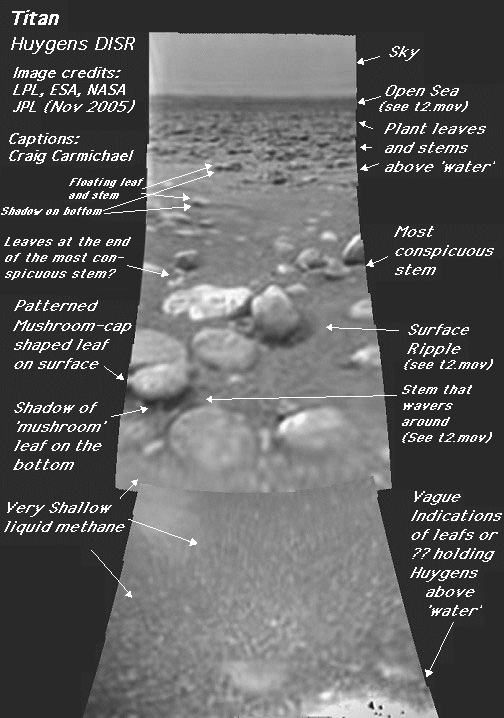
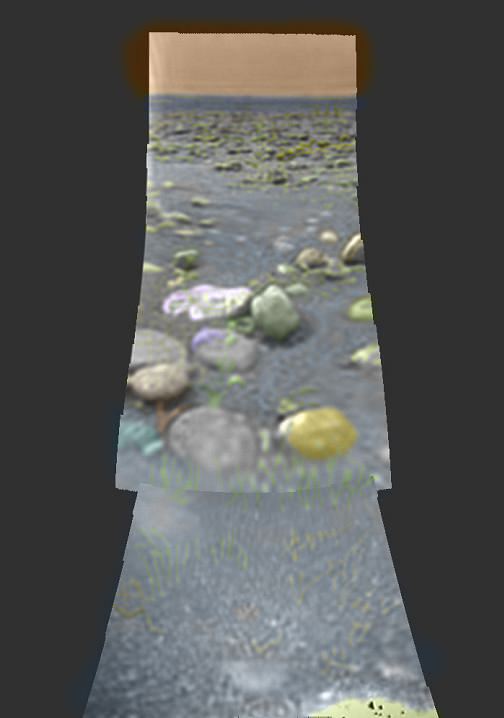
Here's a great new (Nov. 2005)
processed, radiometrically
calibrated
image of the landing view by the DISR team.
It seems to bring out some details of
stems, shadows and
patterns
that were less clear in the raw images, and Huygens' light hitting the
MRI image towards the lower right is well compensated for. In the
animation,
many small nearby stems seem to wave back and forth with the flow,
especially
at the bottom of the upper SLI image.
My colorized version on the right is
intended to bring out
details
of plant stems and small leaves.
Are those bits in the foreground 'duckweed' floating on the 'water',
tiny plants coming up, or large particles of silt? Animating the MRI
images
shows they don't drift around, so they aren't duckweed.
Notice that many of the shadows appear consistent with leaves above
the surface rather than with rocks on the surface. Some farther back
appear
to be possibly reflections of the leaves in the liquid.

Here is yet another rendering of the view from on the ground. I
attempted to improve the resolution over any single image by expanding
several images and blending them together, then applying edge
sharpening.
At the bottom, the leaf(?) in front of the MRI & HRI imager windows
moved a couple of times, and I used images from later on when it
blocked
less of the view.
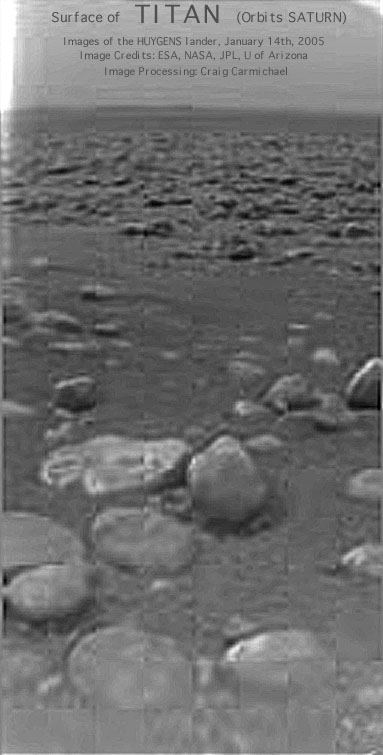
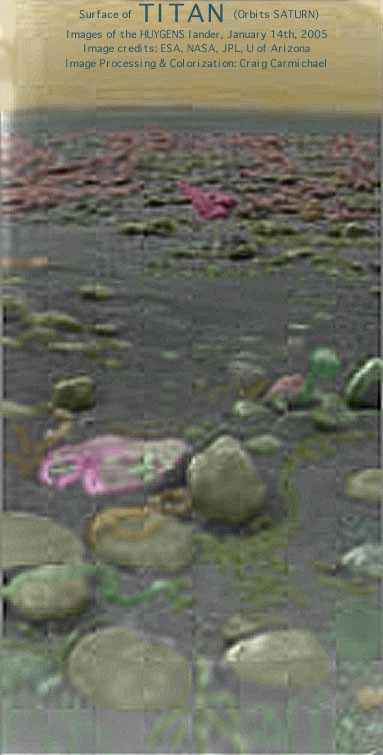
As far as I know, this is the clearest view
yet of Titan's
surface.
The visual improvement is great enough that I feel my colorized image
is
sufficient commentary about the nature of what we seem to be seeing on
Titan!
In reviewing these higher resolution images,
I suspect liquid
methane
may have splashed on the SLI imager window during the landing, such as
one 'smear' along the top (mostly cropped off in this image), the
blurry
area at the bottom, and the left edge near the top. This last appears
to
run down in a streak more towards the middle, causing blur of the image
in its path. Perhaps several of the vertical features are streaks,
rivulets
of methane on the glass, as certain vertical "features" appear to be
superimposed
on the other image features. Later on in the image sequence, a whitish
blob appears in the lower left corner, perhaps having run down the
window
from above and accumulated on the 'window sill'.
The image was made by blending six SLI
images at 3 x
magnification
and then using an "unsharp mask" sharpening filter, set to ~1.5 pixels
radius, ~300%.
I think it is the heat wave 'rippling', coming (no doubt) from
Huygens
itself, that provides much of the fraction-of-a-pixel motion between
frames
that allows improved resolution by combining several images.
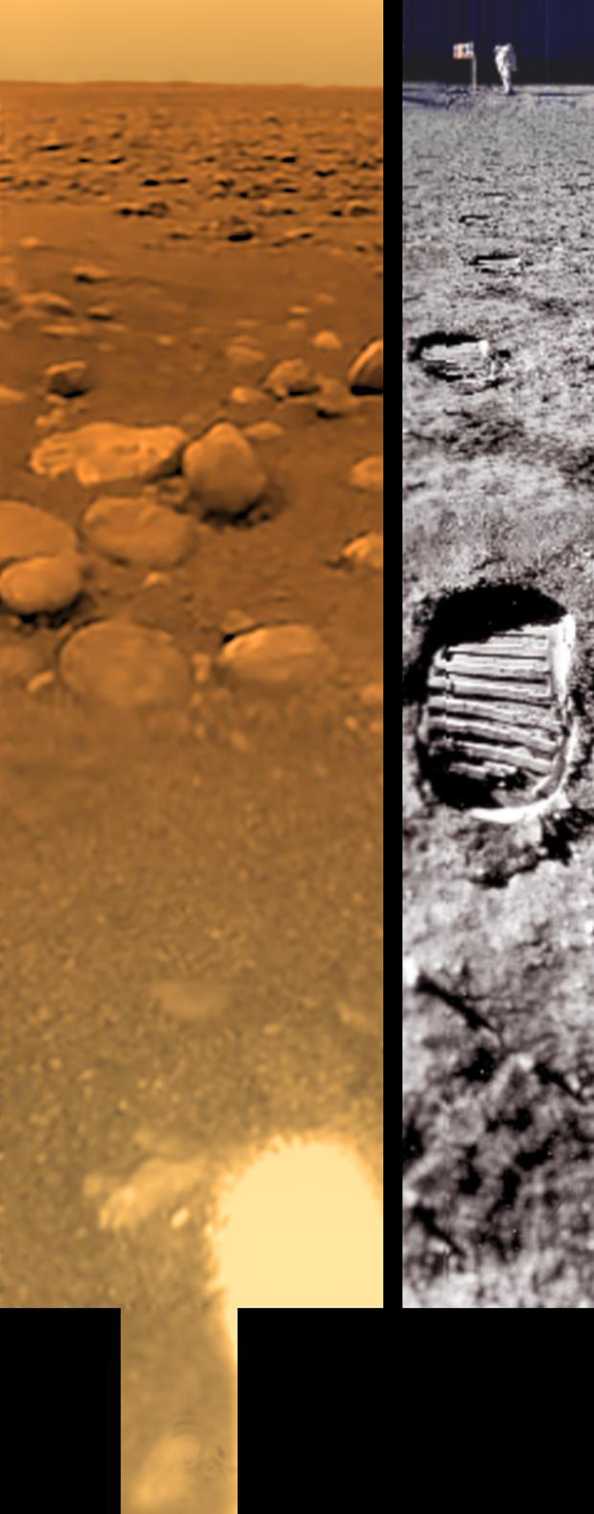
July 15 2006: This excellent image, PIA08115 (here reduced in size)
from DISR, was posted almost the same day as my last one. It has
generally
better quality, the image artifacting has been filtered out, and
problem
areas
have been well treated. The left edge has been cropped, removing the
troublesome upper part, but unfortunately also some interesting bits
lower down. The view of The Moon on the right gives a sense of the
image
scale: Things are closer and smaller than expected because Huygens'
imagers
are quite low to the ground compared to a standing person, and maybe
Titan's
closer horizon plays a part as well.
Fine MRI and HRI views are shown. There are
some interesting
features that
are probably small plants about at the margin between the SLI and MRI
view,
though their exact forms remain
elusive. Near the bottom of the MRI area is a very peculiar form that
proves
you can't go fishing anywhere without dredging up an old shoe! The HRI
section is inevitably badly out of focus: one can't look
clearly at one's feet through a telescope - here we needed instead more
of a
microscope, or perhaps a magnifying glass!
The color is unfortunately taken from data that captures only 6 pixels
through the entire SLI view, so it can only give a vague impression of
overall color and not distingush different colored objects.
Some of what I was calling "mud on the
glass" at the upper side
of the far
shore in my image, towards the left, could possibly be big seaweed
leaves draped on top of
other things, hence the appearance of features crossing over other
features
without completely obscurring them could be real.
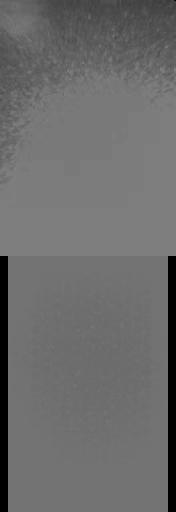
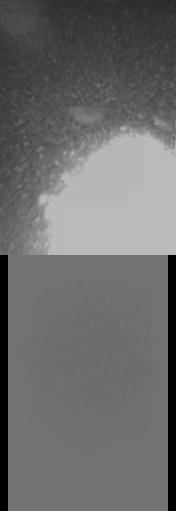
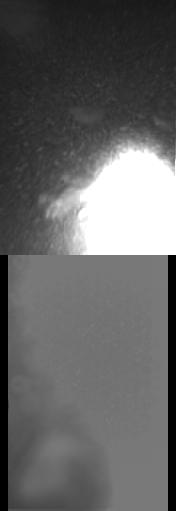
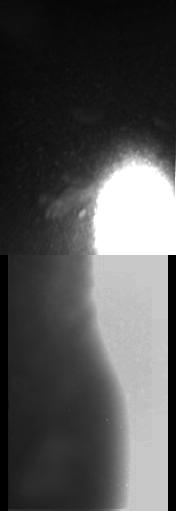
Huygens Images MRI & HRI 723, 823, 948 & 1191 (AKA 167)
Note that the items in the view are in liquid and are only an inch or 2
or 3 away, and that the cameras are looking down at a steep angle.
Here we see something has pretty much blocked the view of both these
imagers immediately after the landing.
My guess is that it's a leaf. (There are other possibilities. The
featurelessness is a bit puzzling, although it must be way out of
focus.)
A while later it has moved part way out of the MRI (top), exposing an
intriguing scene.
My guess is that it's mostly a mossy textured undergrowth, and that
Huygens landed on this cushion.
(...after the penetrometer punched through the "sod" & roots.)
Still later it has moved a bit farther, opening the view of the MRI
further, and of the HRI a bit.
It is also now catching Huygens' spotlight and is overexposed,
darkening the background.
Not long before contact was lost (over an hour), it had moved still
further, but also caught more of the spotlight.
IIRC, the spectroscopes resolved just a few
pixels across the
entire
image view, much larger than the individual fine image features here,
so to
a great extent we
have merely the average of the colors. It's probably better than
monochrome,
but not by much. One can't discern by color, for example, whether the
larger
roundish objects at the bottom of the SLI view are similar color to the
things that are definitely attached to stems. A greatly different
color might indicate they are unrelated, for example they might be
clams
rather than leaves. The left one especially seems clam shaped.
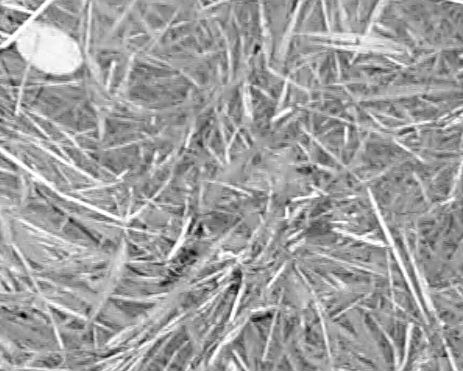
Grass in an inch of water. Note the reflections that show a few
stems are above water, and the shadow of the leaf in the upper corner,
and compare these with the shadows in the Huygens surface images above
this one.
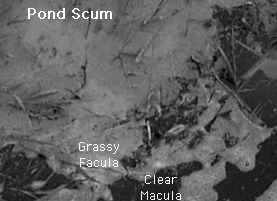
This image shows how difficult interpretation of image features
on a living world can be in monochrome. Can you discern which areas are
duckweed and which are white foam? Can you tell which blades of grass
are
vertical and which are horizontal?
(Color image "answer" below.)
.
.
.
.
.

Color image "answer" to monochrome image.
Animal Life
There are promising signs of possible
animal life,
but
nothing that seems reliable beyond serious doubt. There are a couple of
things that look perhaps like starfish in the after landing view. One
appears
to be sitting on a large leaf and weighing it down. Something drifts or
swims by while Huygens is on the ground, appearing in just one of the
MRI
frames,
but it is pretty small and formless and could be almost anything.
It only stands to reason that
anything but Titanic
(huge)
animals would have been too distant for Huygens to make out during most
of the descent, and alas there are no pictures between 1/2 kilometer
elevation
and the ground. At some earlier points I thought I could see a the head
of a seal, a giant newt and a huge squid in the descent images, but
upon
further examination they don't seem very convincing. The "seal head" is
probably some vegetable apparition similar to the floats put up by kelp
only much, much larger. (Image SLI 698. Many large roundish "kelp float
balls" are also visible in HRI images.)
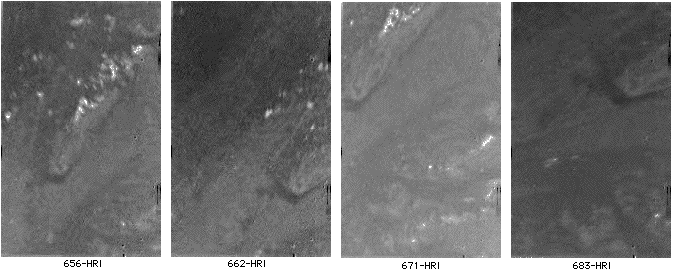
What looked to me rather like a
"newt" appears to be a geological
formation of some
sort (plus the usual sprinkling of seaweed) or may itself be a mass of
seaweed.
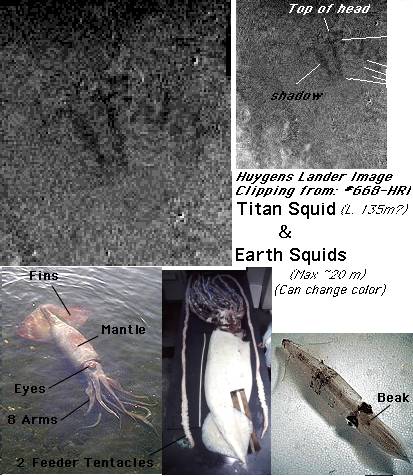
This "squid" is more believeable
in size but at 100+
meters
still way bigger than any Earth creature. At least some of its
"tentacles"
look like seaweed. It certainly appears to cast a shadow that indicates
it's well off the bottom.
Unfortunately for seeing any land
life, Huygens
descended
over the 'water' area, and the last views of land (besides small tide
flats
or mud or silt bars) [it turns out they're dune crests] are from almost
three kilometers up:
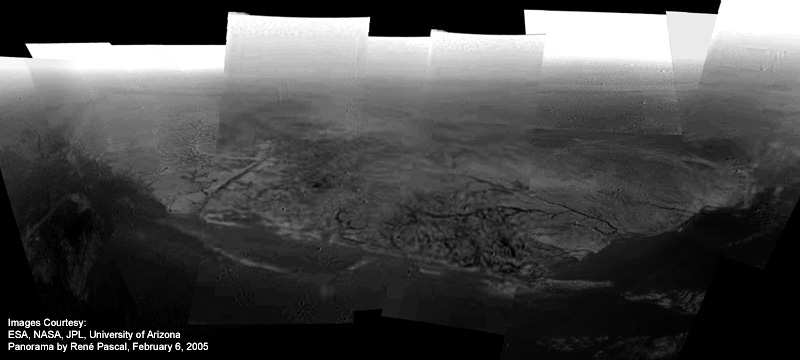
Almost at the right end of the "land",
we
see a big fat stem
of
a giant plant, rising from the sea and climbing onto the shore. Such
stems
creeping onto the shore appear here and there in the images, mostly
distant
views, and also in the closest Cassini images from space. The plants
seem
to spread like horizontal vines, stems with branches growing out of
them.
Or, my Earth viewpoint may be backwards, and these are plant roots on
the
land, supplying plants in the liquid. A third possibility is that the
function
of these growths is to collect and metabolize hydrocarbon haze
particles
drifting down from the upper atmosphere. Whatever, this whole landscape
has neither rivers nor roads nor linear fissures, but giant plant
growths
creeping between the sea and the land! The near point of land looks
especially
'bushy' or at least convoluted. The long skinny "islands" offshore also
seem to be stems of plants. Other broader islands could be leaves or
mats
of leaves, or mud/silt bars. The area of strange sea plants shown in
photos
above is partly in view at the far left, including the "bent arrow".
Behind
the island are seen the linear features dubbed "cat scratches" when
fields
of them, lined up, were seen by Cassini radar, and which may be huge
plant
stems, aligned with the tidal flows. The closest one looks like it is
connected
to the large root or vine system towards the left side of the island.
(Panorama by René Pascal:
http://www.beugungsbild.de/huygens/huygens.html)
A point of indirect evidence in
favour of the
existence
of animal life is something that looks like a large leaf with two spots
and some lines on it, seen just above the "shoreline" just right of
center.
It reminds me of tropical plants whose leaves or flowers mimic very
specific
flying insect parts, in order that that insect will land on it and try
to "mate" with it, thereby (iirc) pollenizing the plant. I can't think
of a reason the "leaf" (or is it a flower?) should be so decorated
unless
there are pollinators to trick.
My opinion at the moment, barring
spotting something
more
definite, is that Titan probably has animal life just because it has
plant
life that looks quite far evolved, but anything one might consider to
be
direct evidence is highly suspect. Is it possible for a world to have
evolved
all that interesting plant life and yet have no amimal life so far?
Cassini Views
Having glimpsed the nature of the
landscape with
Huygens,
we can now turn to some more distant views from Cassini and make sense
of them, which we wouldn't have been able to do without Huygens. That
individual
plants appear to be visible from space as far as Cassini must stay from
Titan is remarkable to say the least. Color photography from Cassini's
VIMS camera shows the colors of the objects within or covering much of
the liquid are different from the land surface color.
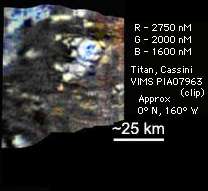
ColorCassini VIMSview showing Titan's
colorful seascape in "false" infrared colors. (Makes my colorizations
look
conservative!) It appears to reinforce the Huygens plant views.
Best guesses: The whitish areas are land areas, above liquid. The
dotty blue areas on the land are roots or vines. Compare the 'vines'
and
gaps between islands with the Huygens panorama above. The one at the
top
may be holding the ground in place with its roots and preventing the
tide
from washing it away. Irregular dotty linear features in the sea would
seem to be aquatic leaves and stems. The scale is mind boggleing.
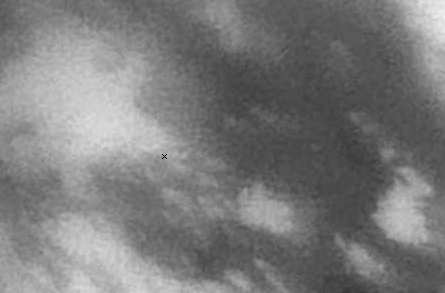
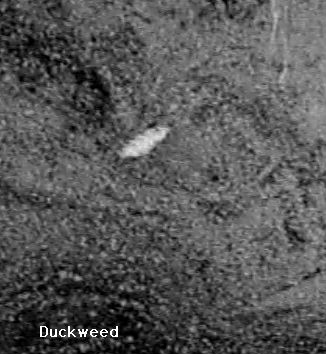
Patterns of floating
duckweed .
in spite of the differences,
compare with the Cassini images.
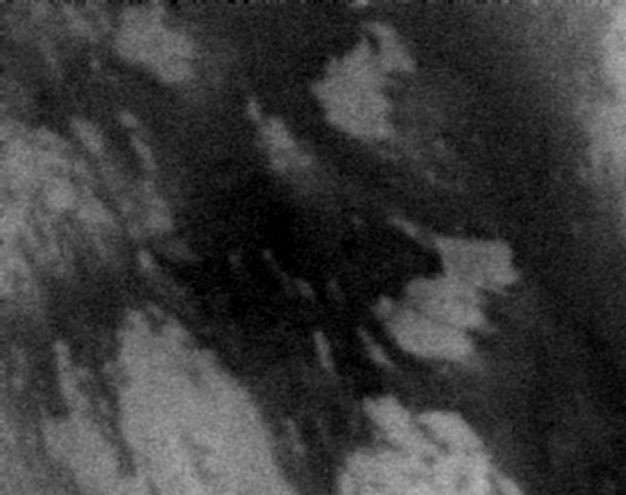
 Clippings of Cassini Titan images from
space (Top & Left
or Middle). The second image was evidently taken from just 1200 Km
above
Titan's surface which possibly makes the rez 7 meters/pixel - most are
from much greater distances. At the finest visible levels, the features
vaguely correspond, but exact matches are not seen. This is true in any
digital images, but more so here. We are probably seeing finer detail
than
it might seem when comparing the two images. Factors causing
differences
from image to image of the same area include (a) atmospheric
distortion,
"twinkling", which may shift the position of a feature as well as make
it more or less visible, (b) the time of day of the image, because the
shadows of the vines, especially on land, will move and change in form
and intensity, (c) the tidal flow because it may cause aquatic plants
to
shift in position and orientation, and (d) the actual sea level with
changing
tide, though I'm still looking for a definitive view of this. For
comparison,
the image of Enceladus terrain from 5200 Km at 30 meters/pixel (right
or
below) shows the quality of the optics.
Clippings of Cassini Titan images from
space (Top & Left
or Middle). The second image was evidently taken from just 1200 Km
above
Titan's surface which possibly makes the rez 7 meters/pixel - most are
from much greater distances. At the finest visible levels, the features
vaguely correspond, but exact matches are not seen. This is true in any
digital images, but more so here. We are probably seeing finer detail
than
it might seem when comparing the two images. Factors causing
differences
from image to image of the same area include (a) atmospheric
distortion,
"twinkling", which may shift the position of a feature as well as make
it more or less visible, (b) the time of day of the image, because the
shadows of the vines, especially on land, will move and change in form
and intensity, (c) the tidal flow because it may cause aquatic plants
to
shift in position and orientation, and (d) the actual sea level with
changing
tide, though I'm still looking for a definitive view of this. For
comparison,
the image of Enceladus terrain from 5200 Km at 30 meters/pixel (right
or
below) shows the quality of the optics.
On the northwest island especially (2nd image) as well as elsewhere,
the outlines of huge "vine" plants or root systems of sea plants seem
to
be visible coming out of the sea and spreading across the land,
similarly
to those on the island Huygens viewed. The dotty patches in the sea
also
seem to be plant parts - even individual branches of leaves seem
visible
here and there, though accumulations of duckweed on Earth ponds can
have
a similar appearance and they are actually composed of many small
independent
leaves (see duckweed image above). The shorelines seem indistinct
probably
partly because of the gradually shallowing liquid and beaches, and
partly
because in that shallower liquid, more plant leaves cover the surface.
All those plant leaves on the sea surface probably confuse radar
findings,
searches for glints of light off open liquid, and spectral readings
expecting
liquid methane. Note also the streaks of the tidal flows, silt probably
creating shallows in the tidal lee of the islands. Titan's tropics may
be vast swampy wetlands.
The top image only vaguely corresponds with the view from Huygens,
whose landing area is, unfortunately, just to the left of the second
image.
(More recent imaging has located the actual landing spot within Cassini
space views.)
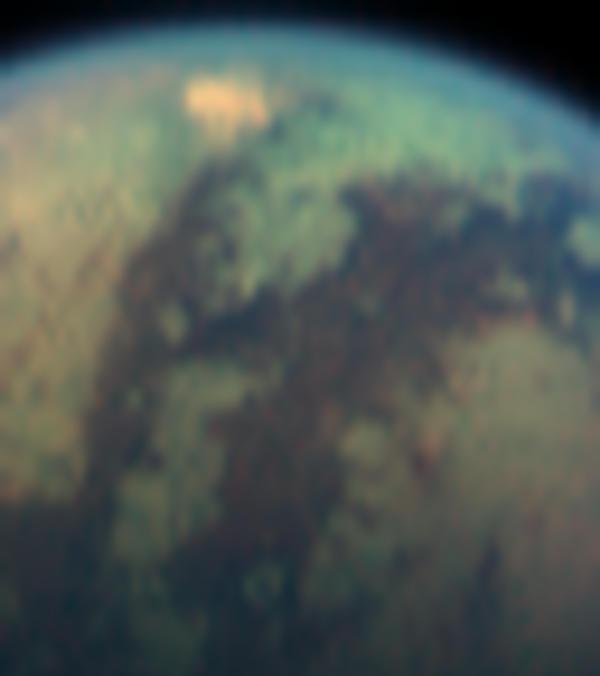
This color image of the South- and North- Saturn-facing Seas
was
taken
by Cassini's Visual and Infra-red Mapping Spectrometer.
(The equator runs between the two seas, South is left, and about the
image bottom directly faces Saturn.)
The image appears to
show
'reddish' colored aquatic plant growth obscurring much of the sea
surface, blunting the "spectral reflections" that were expected for a
liquid surface and resulting
in the plainly erroneous conclusion that the bodies that appear to be
liquid must be dry, which
conclusion also contradicts the T14 radio occultation & Bistatic
Scattering experiment in which
"periodic areas with a dialectric constant (1.6) consistent with liquid
hydrocarbons" [these would
be deeper areas] were detected with
"chaotic terrain" [vegetation sticking out of the liquid at
the dune crests] between
them, in an equatorial region which is where the duney tidal seas lie.
Discussion of Titan Life
(There may be a bit of repetition between the top
section and this one,
sorry. Needs editing!)
Biochemistry
The most
important aspect to
biochemistry
on an atmospheric world would be the thickness of the atmosphere.
Temperature,
gravity, length of day and seasons, nature of the seas if any,
atmospheric
composition, and electrical and magnetic characteristics of course are
also major influences.
Titan's atmosphere is very similar to Earth's:
the pressure is about
1460 millibars or 1.46 times as thick as Earth's, or 21.5 PSI. Because
of the cold temperature, the density is about 4.5 times Earth's. Small
Titan has about 2/3 as much air overall as Earth has, and it extends
much
higher into the sky in Titan's low gravity. Were the atmospheric
composition and temperature suitable, Earth people could comfortably
breathe
there for an extended period of time. Titan is the only world in the
solar
system besides Earth of which this may be said. Venus, for example, has
90 times Earth's air pressure and Mars has just .007 times, 0.7%, while
Earth's Moon and several other worlds have no atmosphere at all. The
whole
system of animals breathing a gas in and out to combust foods to
release
living energy would have to be radically altered on any of these other
worlds.
Huygens' gas chromatograph and mass
spectrometer (GCMS) reported
results
reveal just two major components to Titan's atmosphere. Their ratio at
surface level is nitrogen gas 95% and Methane vapour 5%. The expected
significant
amounts of argon and hydrogen gas were not seen. Earth's atmosphere is
just under 80% nitrogen, and we also have 20% oxygen and 1% argon, as
well
as significant amounts of water vapor. There are tiny amounts of other
molecules in Titan's air just as there is a tiny bit of carbon dioxide
in Earth's atmosphere, and it is likely that at least some of these are
important to Titan's plant life.
Atmospheric nitrogen tends to be biologically
inert as it takes
energy
to decompose it rather than releasing any. Breathing life on Titan, it
would seem, must breathe the methane vapor. Even on Earth, methane can
be a byproduct of life, and it can be burned to release energy. An
interesting
difference is that Titan's methane is a vaporgas that
won't
condense at Earth's temperatures. Titan animal life breathing methane
would
be in some ways analogous to Earth life breathing water vapor, except
that
Titan's methane relative humidity of 50% is probably much more constant
than Earth's widely varying water relative humidity, except perhaps in
Titan's arctic and antarctic regions.
existing at a
temperature
where methane is a liquid, while Earth's oxygen is a
Since Titan has seas of methane, and since it
would seem land life
must
breathe methane vapour, then creatures, or at least certain adapted
creatures,
could possibly breathe both underwater and in the air, or do so for a
time.
Air versus water breathers might be a less clear cut division than on
Earth.
Methane eventually decomposes in sunlight, and its continuing existence
on Titan indicates that it is being replenished. If it is being
breathed
by animals, even more does it need continuous replenishment. In spite
of
12C/13C carbon isotopic readings that might point elsewhere on Earth, a
biological source of replenishment seems very likely, and that's where
plants come in. It appears that the bulk of Titan's methane was
originally
locked up underground in combination with water ice, and that
geological
heating over time in three great epochs cryovolcanically released the
liquid
and atmospheric methane Titan has today. But it is also reasonable to
assume
that plant life on Titan replenishes the methane, as Earth plants daily
renew Earth's oxygen supply.
Much new
information from the Huygens
landing
was made public in December 2005, including statements about the
spectrographic
findings. Spectra of the surface were much different than those of the
atmosphere, indicating complex organic processes are indeed occurring,
unique to the surface. These are the very sort of things one would
expect
to find if there were abundant life on Titan, just such life as seems
to
be shown in the Huygens images, but are difficult to explain away on an
inert surface. Here are some of the statements:
"The
surface
was
also
rich in organic compounds not seen in the atmosphere, for example
cyanogen and ethane, indicating a complex chemistry on Titan's surface
as well as in the atmosphere."
and:
"ammonia and hydrogen cyanide
were the first
molecules
identified.
"This is of prime importance
because ammonia
is
not present as a gas in the atmosphere, hence the aerosols must include
the results of chemical reactions that may have produced complex
organic
molecules. They are not simply condensates.
"Aerosol particles may also act
as
condensation
nuclei for cloud formation, and are the end-products of a complex
organic
chemistry which is important in astrobiology. Indeed, Titan offers the
possibility to observe chemical pathways involving molecules that may
have
been the building blocks of life on Earth."
The whole article is here: http://www.esa.int/SPECIALS/Results_from_Mars_Express_and_Huygens/SEMK1TULWFE_0.html
More was published in the journal Nature
that same month:
"The reflectivity of the
surface at the
landing
site was measured from 480 nm to 1,600 nm without the interference of
methane
absorption bands or haze opacity. The peak reflectivity in the dark
regions
is about 0.18 at 830nm and decreases towards longer and shorter
wavelengths.
The red slope in the visible is consistent with organic material, such
as tholins, but the blue infrared slope is still unexplained. Between
1,500
and 1,600nm the reflectivity is low (0.06) and flat, consistent with
water
ice. Nevertheless, the decrease in reflectivity from 900 to 1,500nm
does
not show the expected weak absorption bands of water ice near 1,000 and
1,200 nm, and the identity of the surface component responsible for
this
blue slope remains unknown." --
Nature04126.pdf
The several Nature articles were found
here:
http://www.nature.com/nature/focus/huygens/index.html
My appraisal is that the entire area, if not
the entire tropical
surface
of Titan, is a sort of giant wetlands. Huygens appears to have landed
on
something like a "silt bar" partly covered with vegetation, probably
composed
of organic sludge raised by the tides in the sea to just about surface
level. I would suggest there was nowhere for the spectrometers to look
and Not see organic matter and life, and having viewed the images these
findings don't seem surprising. Whence cometh this complex organic
chemistry
with unexplained spectra if not from life? Can it all be explained by a
dead, dry surface with rocks on it?
Character of Titanian Plant Life
On a clear day
with the sun overhead,
sunlight is delivering 100 watts per square foot to the Earth's
surface.
Saturn and it satellites receive only one watt. Titan under its rather
obscurring atmosphere receives considerably less solar energy,
currently
estimated at around 1/10th watt per square foot. This is still 350
times
brighter than Earth under our full moon. In our north on an overcast
winter's
day there is also only 1 watt. Even on Earth, there are deeper sea
plants
and perhaps shade-loving plants that thrive with as little light as
Titan
gets or less. So energy-wise, plants are possible but likely to be
slower-growing.
On the other hand, the limiting factor to plant growth on Earth is not
sunlight but the availability of that vital trace gas, carbon dioxide
(CO2).
If extra CO2 is introduced in a greenhouse, plants grow faster.
There is probably a trace gas or multiple trace
gasses plants need
for
photosynthesis on Titan, too, so if that is somewhat more abundant than
our CO2, it does not necessarily follow that Titanian plant growth is
hundreds
of times slower than Earth's. Indeed, one may suspect from their size
that
they must grow rapidly indeed, or else live a very long time. Plants
could
also filter out various trace organic aerial compounds for their
carbon,
and combine the carbon with the hydrogen to produce... you guessed it,
CH4, methane. One report suggests that Titanian plants could gain
indirect
solar energy by converting the energetic particles formed by
ultraviolet
induced methane breakdown in the upper atmosphere (where the sunlight
is
full strength), and thence drifting down to the surface, back into
methane,
and that this cycle could actually provide more energy than direct
photosynthesis
itself.
Two factors limit the size of trees on Earth:
gravity and wind.
Titan
has only 1/8 of our gravity but the air is thicker, so how tall plants
and tress can grow on Titan is likely to be limited by their resistance
to being uprooted or broken by the wind, which in turn is related to
the
highest normal wind speeds. Huygens measured 15 Km/hour surface winds,
but we have little idea whether more severe weather is to be expected
frequently,
rarely or never. But Titan does not currently seem to have trees as
such.
Instead, various types of gigantic vines, or the root systems of
various
aquatic plants, grow out of the sea and spread over the land. They all
seem to originate or end in the sea. Perhaps the land is currently too
dry to support plant life. Earth was very dry in the Permian period and
the early Triassic period on Earth.
Other aquatic plants prefer to stay in the
methane, growing leaves
up
their long stems or growing up to the surface and forming giant "water
lilly" mats. Whatever else they are, some Titan plants are Titanic!
(What
a well-named planet!) It is possible Cassini has been seeing beds of
them
from space, and it seems small wonder that the shallow, very
transparent
seas with mats of leaves on the surface don't provide very distinct
shorelines
to Cassini's imagers.
I should mention some forms of Titanian plant
life I've noted but
haven't
touched on elsewhere.
One is "Titanian Kelp". On Earth, beds of kelp
grow in shallower
ocean
areas with strong waves. These annuals consist of anchor roots, a very
long stem, a float bulb, and limp leaves. The float bulb drags the
leaves
up to the surface where there is the most light. Titanian kelp is
probably
similar, but the float bulbs and their waving leaves seen in the
descent
images are gigantic, instead of bulbs just a few inches across.
Features
in SLI 698 (below left) may be a bulb and some leaves. The possible
"bulb"
looks like it has eyes, and double eyelike features are seen in a
number
of other places as well.
Another is, for want of a better word,
"horsetails". There are what
appear to possibly be striped stems at various sizes from huge in the
descent
images to small at the bottom center of the SLI after landing images.
This
and other vaguer ones on the ground are too close to the camera and out
of focus, and may be ordinary dark stems with leaves at intervals (they
may be "horse tales" instead!), but the ones in the descent images
certainly
have much the appearance of horsetails.
Finally, features dubbed "cat scratches" in
Cassini RADAR images
seem
to be giant horizontal floating stems, aligned with the tidal flows.
Two
match up between the RADAR and distant Huygens views. One in the
Huygens
views appears to connect with the huge root or stem crossing the land
area
and once dubbed the "landing strip". What may be a smaller specimen of
one of these is seen floating on the sea in image SLI 710. (Note the
"horsetail"
stripes on the stem.)
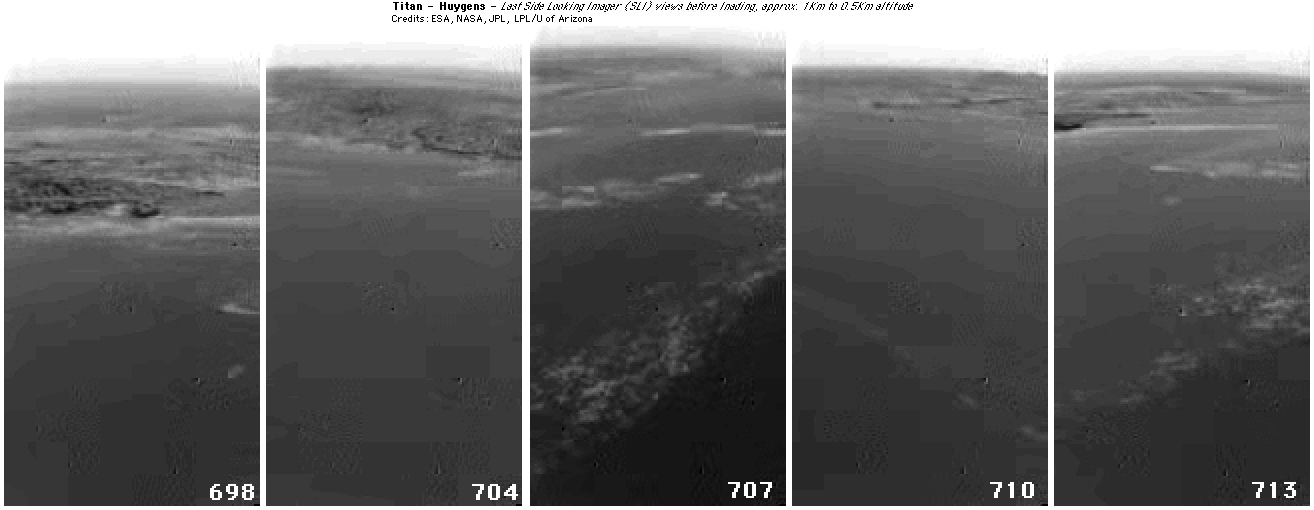
Character of Titanian Animal Life
We can probably
expect primitive
animal
life such as shellfish, sea worms and so on to be as abundant on Titan
as on Earth. Many species might be similar to Earth's, or there might
be
species dissimilar to any we've encountered here. Evolutionary
potential
seems to be essentially "pre-programmed" into the genes of the first
life
according to some recent studies, and the species that evolve depend on
the ever-changing environmental conditions, and to some extent, "luck".
Obviously, if there were no oceans, there would be no sea life, and if
the air was too thin, there would be no birds. Earth's flying reptiles
could perhaps have outlived the dinosaurs if they had evolved a bit
differently,
and if they had, we might have a few small species of them in warmer
climates
today. If we saw flying reptiles or quite unfamiliar creatures on Titan
amongst other more familiar forms of life, we shouldn't be too
surprised.
The potential size of animals to be expected is
interesting.
Intuitively,
if the world is smaller, the life will be smaller, but this does not
follow.
In fact, with only 1/7 gravity pulling it down, much larger animals
might
be expected. For example, on Earth a person twelve feet tall would have
to be built somewhat like an elephant to support his own weight. On
Titan,
a twelve foot tall person could be quite lightly built, and might have
longer legs in proportion to his body than an Earth person. We might
also
anticipate many species of birds and other flying creatures with small
wings, as the light gravity and thicker air should make flying rather
effortless.
The motions of the animal life would probably be slow and graceful by
Earth
standards, as the muscle mass we need to exist and move around just
isn't
required on Titan. It would probably be more important for animals in
their
quest for survival to use less energy and hence need less food.
(Earth's
sloths do something of this nature, but they doubtless shouldn't be
considered
a close parallel.) And the hydrogen that is evidently the
breathing gas is thought to be only 1% of the air (+90% nitrogen, +5%
methane vapor, 4% Argon... IIRC), where on Earth our oxygen is about
21%, which might make breathing somewhat different. One expects the
entire pace of life must be slower on
Titan,
with the lazy gravity, the low temperature, and the extraordinarily
long
day and year.
However, the only possible signs of Titanian
animal life are sketchy
at best.
July 2006: I've just looked at PIA08112 and other recently released
COLOR
images from the Huygens probe. PIA08112 is a bear to download and try
to
view, but it is six of the best views ever done of Titan looking
downwards
as Huygens descended. It appears the spectrographic data was
incorporated into
the imager data to provide actual if low-rez color, but the caption is
unenlightening. I can't say with any
sort of assurance, but there are some patches, especially at the right
end of the "oval", that are most reminiscent of "bio-diverse" beds of
mussels
and clams with seaweed
and snails, attached to rock outcroppings. (but if so, they are
gigantic!)
Mussels and clams are
of course animals, with freeswimming larvae, so this (along with the
idea that
some of the roundish objects in the after landing view may be clams) is
another bit of - very tentative - evidence of animal life on Titan.
Or it could all be seaweed or even boulders, giant
gravel bars. This excerpt is from 8112's third view (middle left):
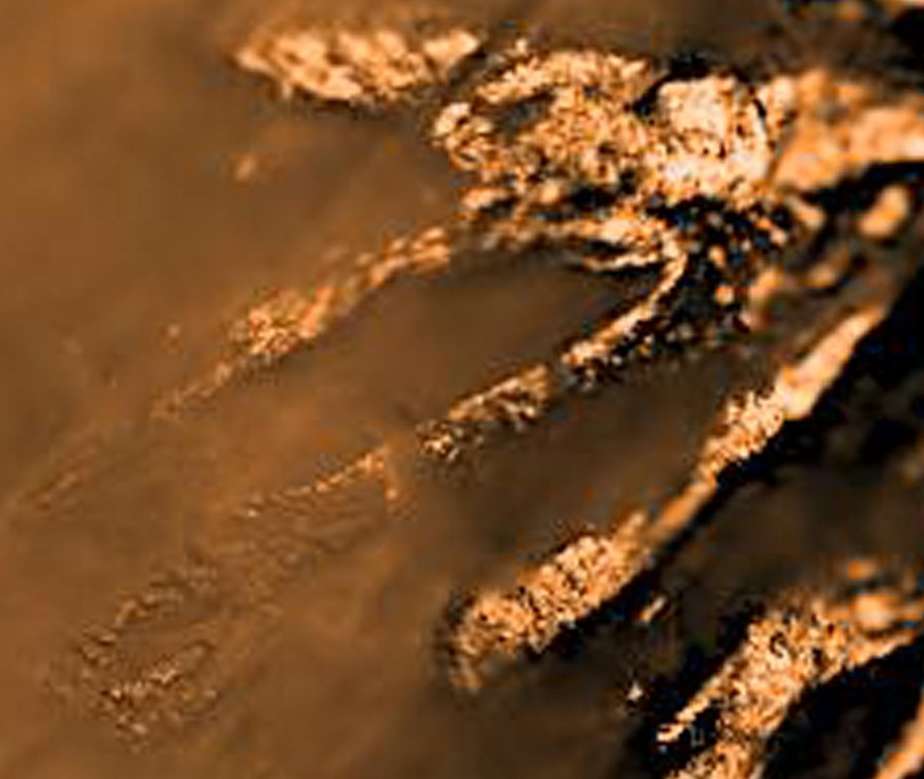
Excerpt from PIA08112-c. Huygens' landing site is towards the lower
left. Near the shores, one seems to get some idea of the depth of the
liquid,
and there is the sense that liquid is flowing, pouring over the rock,
from
left to right, Eastwards. This is in fact the correct direction for the
tidal flow at the time of the landing.
Copyright
2005 Craig
Carmichael
all rights reserved
August 6th, 2005
rev aug. 15th 2005
rev Aug 21 2005
rev Aug 23 2005 (Cassini images of plants from space (!) )
rev Aug 24 2005 (Edit based on Cassini images, replacing speculation
about what Cassini might see with what it has seen.)
rev Aug 25 2005 (better notes about the Cassini images.)
rev Aug 27 2005 (Plants in "sprays" image)
rev Aug 31 2005 (Colorized images, after adding a "colorize" function
to my "Paintbooth" program in 4 hours yesterday, then spending a few
more
hours colorizing!)
rev Sept 16 2005 (Added speculative colorized image of landing ground,
etc)
rev Sept 18 2005 (Added Cassini VIMS image showing sea plants)
rev Nov 30 2005 (Added new DISR image of landing ground)
rev Dec 10t 2005 (Colorized the DISR image; notes about newly released
spectral readings from the surface: Titan "Biochemistry"; Note about
the
so-called island)
rev April 11th-12th 2006. (Very extensive overall revision. I plan
to do more editing, but I want to get this much up for now.)
rev April 14 2006 (Added yet another view of the scene from the ground;
also changed "Animal Life" a bit.)
rev April 18 2006 (I simply couldn't resist adding this, perhaps the
best resolution view yet of the ground scene with some comments that
may
be useful.)
rev May 7 2006 (Deleted previous image of April 18th and added a much
better one, with a colorized copy as well!)
rev July 17 2006 (Added some recent DISR images, with my own captions
of course: color Huygens image
showing what could look like beds of gigantic mussels on rock
formations;
a very fine (The Best!) color image of the landed view.)
rev June 17 2007 (Added a new view of the "island" as shallows full of
floating vegetation.)
Jan 25 2023 A few notes & misc. for new upload to
TurquoiseEnergy.neocites.com
Jan 27th 2023: The Forests of Titan - These were discovered by Cassini
SAR radar a little after I had written the rest. They deserve to be
covered.























